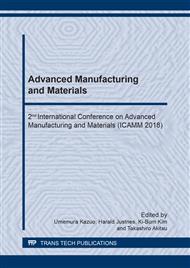p.120
p.127
p.133
p.141
p.147
p.155
p.163
p.170
p.177
Patterned Magnetorheological Elastomer Developed by 3D Printing
Abstract:
This article delineates the characterization of the 3D printed MR elastomer through a forced vibration technique in the squeeze mode of operation. An anisotropic hybrid magnetorheological (MR) elastomer is developed via 3D printing. The 3D printed MR elastomer consists of three different materials; magnetic particles, magnetic particles carrier fluid, and an elastomer. MR fluid filaments are encapsulated layer-by-layer within the elastomer matrix using a 3D printer. When a moderately strong magnetic field is applied, the 3D printed MR elastomer changes its elastic and damping properties. The hybrid 3D printed MR elastomer also shows an anisotropic behavior when the direction of the magnetic field is changed with respect to the orientation of the printed filaments. The relative MR effect is higher when the applied magnetic field is parallel to the orientation of the printed filaments. The maximum change in the stiffness is observed to be 65.2% when a magnetic field of 500 mT is applied to the MR elastomer system. This result shows that the new method, 3D printing could produce anisotropic hybrid MR elastomers or possibly other types.
Info:
Periodical:
Pages:
147-152
Citation:
Online since:
November 2018
Authors:
Keywords:
Price:
Сopyright:
© 2018 Trans Tech Publications Ltd. All Rights Reserved
Share:
Citation:


